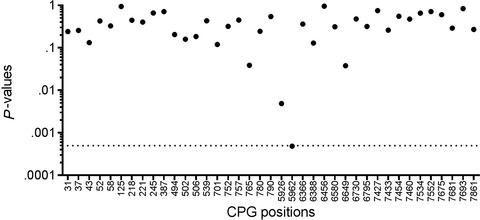当前位置:
X-MOL 学术
›
Cancer Med.
›
论文详情
Our official English website, www.x-mol.net, welcomes your feedback! (Note: you will need to create a separate account there.)
Methylation of CpG 5962 in L1 of the human papillomavirus 16 genome as a potential predictive marker for viral persistence: A prospective large cohort study using cervical swab samples.
Cancer Medicine ( IF 4 ) Pub Date : 2019-12-19 , DOI: 10.1002/cam4.2771 Jasmin Fertey 1 , Jörg Hagmann 2 , Hans-Joachim Ruscheweyh 3 , Christian Munk 4 , Susanne Kjaer 4 , Daniel Huson 3 , Juliane Haedicke-Jarboui 1 , Frank Stubenrauch 1 , Thomas Iftner 1
Cancer Medicine ( IF 4 ) Pub Date : 2019-12-19 , DOI: 10.1002/cam4.2771 Jasmin Fertey 1 , Jörg Hagmann 2 , Hans-Joachim Ruscheweyh 3 , Christian Munk 4 , Susanne Kjaer 4 , Daniel Huson 3 , Juliane Haedicke-Jarboui 1 , Frank Stubenrauch 1 , Thomas Iftner 1
Affiliation

|
Several studies have demonstrated that the viral genome can be methylated by the host cell during progression from persistent infection to cervical cancer. The aim of this study was to investigate whether methylation at a specific site could predict the development of viral persistence and whether viral load shows a correlation with specific methylation patterns. HPV16-positive samples from women aged 20-29 years (n = 99) with a follow-up time of 13 years, were included from a Danish cohort comprising 11 088 women. Viral load was measured by real-time PCR and methylation status was determined for 39 CpG sites in the upstream regulatory region (URR), E6/E7, and L1 region of HPV16 by next-generation sequencing. Participants were divided into two groups according to whether they were persistently (≥ 24 months) or transiently HPV16 infected. The general methylation status was significantly different between women with a persistent and women with a transient infection outcome (P = .025). One site located in L1 (nt. 5962) was statistically significantly (P = .00048) different in the methylation status after correction using the Holm-Sidak method (alpha = 0.05). Correlation analyses of samples from HPV16 persistently infected women suggest that methylation is higher although viral load is lower. This study indicates that methylation at position 5962 of the HPV16 genome within the L1 gene might be a predictive marker for the development of a persistent HPV16 infection.
中文翻译:

CpG 5962在人乳头瘤病毒16基因组L1中的甲基化作为病毒持久性的潜在预测标志物:一项使用子宫颈拭子样本的前瞻性大型队列研究。
几项研究表明,病毒基因组可以在从持续性感染发展为宫颈癌的过程中被宿主细胞甲基化。这项研究的目的是调查特定部位的甲基化是否可以预测病毒持久性的发展以及病毒载量是否与特定的甲基化模式相关。来自丹麦队列的11088名女性中,HPV16阳性样本来自20-29岁(n = 99)的女性,随访时间为13年。通过实时PCR测量病毒载量,并通过下一代测序确定HPV16上游调节区(URR),E6 / E7和L1区的39个CpG位点的甲基化状态。根据参与者是持续感染(≥24个月)还是短暂感染HPV16,将其分为两组。持续性女性和短暂性感染结果女性的总体甲基化状态显着不同(P = .025)。在使用Holm-Sidak方法校正后,位于L1的一个位点(核苷酸5962)的甲基化状态在统计学上有显着差异(P = .00048)(alpha = 0.05)。对来自HPV16持续感染妇女的样本进行的相关分析表明,尽管病毒载量较低,但甲基化水平较高。这项研究表明,L1基因内HPV16基因组5962位的甲基化可能是持续性HPV16感染发展的预测标记。00048)在使用Holm-Sidak方法校正后的甲基化状态有所不同(alpha = 0.05)。对来自HPV16持续感染妇女的样本进行的相关分析表明,尽管病毒载量较低,但甲基化水平较高。这项研究表明,L1基因内HPV16基因组5962位的甲基化可能是持续性HPV16感染发展的预测标记。00048)在使用Holm-Sidak方法校正后的甲基化状态有所不同(alpha = 0.05)。对来自HPV16持续感染妇女的样本进行的相关分析表明,尽管病毒载量较低,但甲基化水平较高。这项研究表明,L1基因内HPV16基因组5962位的甲基化可能是持续性HPV16感染发展的预测标志。
更新日期:2019-12-20
中文翻译:

CpG 5962在人乳头瘤病毒16基因组L1中的甲基化作为病毒持久性的潜在预测标志物:一项使用子宫颈拭子样本的前瞻性大型队列研究。
几项研究表明,病毒基因组可以在从持续性感染发展为宫颈癌的过程中被宿主细胞甲基化。这项研究的目的是调查特定部位的甲基化是否可以预测病毒持久性的发展以及病毒载量是否与特定的甲基化模式相关。来自丹麦队列的11088名女性中,HPV16阳性样本来自20-29岁(n = 99)的女性,随访时间为13年。通过实时PCR测量病毒载量,并通过下一代测序确定HPV16上游调节区(URR),E6 / E7和L1区的39个CpG位点的甲基化状态。根据参与者是持续感染(≥24个月)还是短暂感染HPV16,将其分为两组。持续性女性和短暂性感染结果女性的总体甲基化状态显着不同(P = .025)。在使用Holm-Sidak方法校正后,位于L1的一个位点(核苷酸5962)的甲基化状态在统计学上有显着差异(P = .00048)(alpha = 0.05)。对来自HPV16持续感染妇女的样本进行的相关分析表明,尽管病毒载量较低,但甲基化水平较高。这项研究表明,L1基因内HPV16基因组5962位的甲基化可能是持续性HPV16感染发展的预测标记。00048)在使用Holm-Sidak方法校正后的甲基化状态有所不同(alpha = 0.05)。对来自HPV16持续感染妇女的样本进行的相关分析表明,尽管病毒载量较低,但甲基化水平较高。这项研究表明,L1基因内HPV16基因组5962位的甲基化可能是持续性HPV16感染发展的预测标记。00048)在使用Holm-Sidak方法校正后的甲基化状态有所不同(alpha = 0.05)。对来自HPV16持续感染妇女的样本进行的相关分析表明,尽管病毒载量较低,但甲基化水平较高。这项研究表明,L1基因内HPV16基因组5962位的甲基化可能是持续性HPV16感染发展的预测标志。


























 京公网安备 11010802027423号
京公网安备 11010802027423号